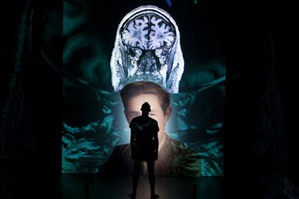HM

 Henry Molaison, HM for short, wanted to be a brain surgeon as a kid. Instead he spent his life as a research subject after an experimental surgery on his own brain left him incapable of forming new memories.
Henry Molaison, HM for short, wanted to be a brain surgeon as a kid. Instead he spent his life as a research subject after an experimental surgery on his own brain left him incapable of forming new memories.
Over the weekend I got to see the last performance of Yesterday Happened: Remembering HM at the Central Square Theater. The play was an interdisciplinary collaboration between MIT’s playwright Wesley Savick and composer Tod Machover and Northeastern’s scenic designer Justin Townsend. It was an extraordinary example of how art can be used to communicate science.
HM developed severe epilepsy as a teenager. In an attempt to cure this disease, doctors decided to remove his hippocampus, his parahippocampal gyrus and his amygdala, having absolutely no clue how such a procedure would affect his mind.
As may seem obvious to us today, the surgery affected HM’s mind quite a bit. Every day he woke up not knowing where or how old he was, whether his parents were alive or dead, or the names of the nurses who had spent years taking care of him. He did seem to retain a sense that his condition was helping other people somehow. And he never lost the ability to do crossword puzzles.
The play was, as I said, extraordinary, something of an experiment itself. Since our man Townsend took care of the set design…and since it was so almost another character in the play, I’m going to describe it to you now: Audience members sat around three sides of the stage, which was just an open floor in the middle of a big room. On the fourth side an image of HM as a young man was projected onto a white wall. Above Henry’s portrait, various other images were projected throughout the show. In the middle of the floor rested an enormous white box lit up from the inside. On either side, a row of horizontal fluorescent lights sat a few feet above the ground while dozens of industrial light bulbs hung from the 40-ft-or-so ceiling. At the back of the stage, on either side of the projection wall, were two tall rolling ladders.
The story took a circuitous path to tell Henry’s story, starting out with HM undergoing a medical inquisition, the simultaneous onslaught of questions repeated day after day for decades. It wandered through his experiences of dressing, sleeping, and doing the crossword puzzle. People in his life came on and off stage to tell the audience what they knew about him, the kind, smart man “with a very bad memory.” These were doctors and schoolmates and nurses and even “actors” auditioning for the part of Henry in Remembering Yesterday.
The smart man with a very bad memory, Henry used logic and reasoning to understand the world around him that could have been an eternal void. It was at times; he said there were holes, gaps in his mind. But his rational skills seemed to have saved him, in a way. This was particularly clear when the character vocalized his experience of doing the crossword puzzle — a process of trial and error, elimination and negation. While he may forget what question he was working he could eventually reason his way to its answer.
One of the most curious things about Henry’s condition was that, while he couldn’t form new episodic memories (nor recall any from before the surgery), he could form functional ones. While he couldn’t learn new names he remembered his own and those of people in his life before the accident. He remembered how to tie his shoes, how to speak and how to do a crossword puzzle but he couldn’t remember what he’d eaten for breakfast any given morning or what season it was.
Clearly the brain is a pretty complex machine. There isn’t just one kind of memory. Each behaves slightly differently and lives in its own part of the brain. To us, today, that’s not so exciting or surprising. But before 1957 scientists didn’t know any of that. They had their suspicions, said one of the characters, but until HM there was no conclusive evidence about how the brain worked. The fact that language is stored in one area and sight in another, for instance. The fact that long term memories and short term memories live in separate areas. The fact that episodic memory is different from functional memory. All of those are new in the last sixty years.
When HM died in 2008 another surgeon removed his brain which now resides at UC San Diego, thousands of slices preserved in a solid polymer. His brain continues to inform science, perhaps a bigger feat than if he’d gone to medical school and become a surgeon.
Oh one more thing. When I said he couldn’t remember any episodes from his pre-surgery life, that wasn’t entirely true. He did remember one single event: the day he got to go up in an airplane and see the world from above. He called it the high point of his life and he remembered it always, indicating that a memory’s significance may send it to a different part of the brain.
Photo by A.R. Sinclair photography.





